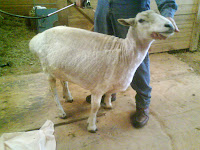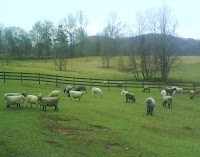... Fleeces Ready To Be Shorn and Spun Into Yarn....
Hello Friends!
Hello Friends!
Well, I finally started a blog. I've been sitting here looking at it for days now, sort of like one of those presents you receive and think, "Wow, that's nice. What am I supposed to do with it?" Since I tend to post updates on Facebook that ramble on far longer than a status update should, I guess I'll use blogging to tell those stories. For starters, spring shearing is this weekend!
We have Corriedale, Cotswold, and Corriedale/Cotswold cross sheep. We shear twice a year, on the last weekend of March and the last weekend of September. In the fall, only the Cotswolds are shorn because they're the only ones who can grow their wool back fast enough to have a decent winter coat. Everyone gets shorn in the spring, though. I'm a bit nervous about this spring shearing because the weather has been so unusually cold this winter. In the last three days alone we've had weather ranging from sunny and 70 to cloudy and snow flurries. The 15 day forecast looks great, but I still worry about all my little woolly babies getting naked and then a cold snap coming. I don't think they're worried about that at all, though. They are more than ready to get those itchy winter coats off! For my first blog post I thought I'd tell you about shearing day so that when I post about it on Facebook you'll know what I'm talking about.
On Saturday Randy, our shearer, will arrive around 9AM. We'll have a system of gates set up in the big stall to allow us to separate the sheep into small groups for the shearing. First in line, though, are the Old English Babydoll sheep, who live in their own stall. These guys are very tiny compared to my Big Folks (think knee-high as opposed to hip-high) so they get their own quarters with a lower feed trough and waterer. Then come my Old Folks, those elderly ewes and wethers who have arthritis and don't get around so well anymore. They also have their own stall-- the Retirement Villa-- where they can eat their hay and grain without having to push and shove with the Big Folks and they can sleep all stretched out without worrying about 40 other sheep walking around, stepping on them. Once they're done, Randy moves on to the Big Folks. He'll shear half the flock the first day and the other half on Sunday. So how do you shear a sheep?
Andrew "Roo" being shorn, spring 2009
We lay out a big plywood board in the alley of the barn to keep the wool clean and to give Randy a level surface to move the sheep around on. Bringing them out one at a time, Randy will lay them back on their butts, turn on his big electric clippers, and start on their tummies, working his way around the sheep from one side to the other. We love Randy because he is so very gentle and sweet with them! Putting them upside down like this makes them a bit catatonic and they will (usually) lay quietly and let him shear. We throw away the wool from their legs, tummies, the tops of their heads, and their faces because it isn't great wool for spinning. What you're going for is the wool from their sides and back.
Annie Pepper before & after shearing, spring 2009
Once they're naked, I take the raw fleece (this is very neat because it usually comes off in one large piece and it's still warm from their body) and pile it on a sheet, tag it with the name of the sheep it came from, and hand it off to my sister. Mom sweeps up the little scrap bits and pieces so the plywood board is clean again and we start on another sheep.
Magic's fleece, spring 2009.
Once sister has the fleece, she weighs it and then skirts it. Skirting is when you strip off all the yucky wool that might be left (say, from around their butts or anything from their tummies that might have gotten mixed in by accident) so that all you're left with is the wool that will be sent off for processing. She weighs this again and writes down the weight of the fleece and which sheep it came from. Then the fleece, tagged with the weight and sheep's name, is sealed in a plastic bag. After shearing all those little bags go off to a fiber mill where they're individually washed, carded, and made into roving. They send them back to us with the original tags that say what sheep they're from. It's very cool to be able to spin the wool into yarn and knit or weave that into something and be able to say, "Oh, this is Annie Pepper" or "This is Gracie Willow."
Spring Shearing 2006 & 2009
The best part of shearing day, though, is that the sheep feel sooooo much better once all their wool comes off. And they're incredibly funny just after they're shorn. They spend about a day having to "get to know" each other again because none of them smell the same now that their wool is gone. And some of them don't seem to realize that, yes, they too were shorn! A freshly shorn one will go out to the pasture and the others will say, "Holy crap! What happened to you? Hahaha.... You look so funny!" Often there's some head-butting involved at this point. The worst part of shearing (other than just the work involved in it) is that a good part of their little personalities is in their wool. I know all my sheep by name and I can look out across the pasture and often tell who is who simply by their wool and their shape. Once their wool is gone that's very hard to do that until they start fluffing up again. Sometimes even up close it's hard to tell one from the other when the wool on their faces is all gone. And, of course, dear old Meg looks forward to getting at least some of her coat back because, as one of our two senior ladies, without her wool her butt looks a bit like an old lady whose nylons are sagging!
I hope you've enjoyed this post. Feel free to make comments and ask questions. I'd like for this blog to be a running conversation, not just me talking to myself!
I hope you have a good day!
Jenna Maclaine






That is a great story. I knew nothing about shearing. My friend at the yarn store gets the raw wool you described and makes is into roving himself before he does whatever else he wants before spinning.
ReplyDeleteIn case it turns out to be too cold for the poor things this year, would you like me to knit the wool into a temporary coat for them?
Your description as a shepherdess was great. Reminds me of Psalm 23 (the Shepherd's Psalm). If you don't mind the Bible too much. I read a lot about shepherds because of the imagery that is throughout the Bible.
Evelyn from Facebook
Your friend is a brave man! Washing and carding wool is not an easy job and I don't know very many people who want do it.
ReplyDeleteThe weather was a bit chilly over the weekend and today but we're supposed to have a high around 80 on Friday so I've very glad they've got all that wool off in time for that! Some of the fleeces were 10 pounds or more so they would have been very hot sheep by this weekend!
No, I don't mind the shepherdess reference at all! I feel very spiritual when I'm in the middle of my flock!
Thanks Evelyn!
I've recently become a knitter and there's a local class on how to spin your own yarn from wool that I can't wait to take. I did grow up on a ranch-type farm, but we didn't have sheep. The shearing process fascinates me, and I really appreciate you sharing this! I'd love to come and spend a day on the farm near/on Shearing Day just to see it for myself. Thanks, Jenna!
ReplyDelete